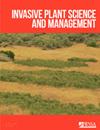Phenologies of Canada thistle (Cirsium arvense) and Cirsium species native to the upper Midwest: implications for the ecological host range of the biocontrol agent Hadroplontus litura
IF 1.2
4区 生物学
Q3 PLANT SCIENCES
引用次数: 0
Abstract
Abstract Native Cirsium species play an important role in landscapes across North America. Hadroplontus litura (F.) (formerly Ceutorhynchus litura), the stem-mining weevil and biological control agent of Canada thistle [Cirsium arvense (L.) Scop.] can complete its life cycle on five Cirsium species native to the upper Midwest. Although these five Cirsium species are within the fundamental host range of H. litura, as determined by host-range tests, we wanted to explore whether phenological differences among Cirsium species help define the field ecological host range of H. litura. The objective of this study was to determine the phenology of Cirsium species native to the upper Midwest in relation to C. arvense and H. litura. Our goal was to explore whether shoots of native Cirsium species could escape H. litura shoot oviposition in spring due to delayed shoot emergence relative to C. arvense. Soil cumulative growing degree days (GDD) were a superior predictor of shoot emergence for perennial Cirsium species or initiation of leaves in biennial Cirsium species, with a 2.4 times larger effect on time to emergence relative to air GDD. All native Cirsium species initiated new leaves or shoots before C. arvense shoot emergence, even when native Cirsium species growth was delayed in the spring. In turn, C. arvense shoots emerged approximately 1 to 3 wk before female H. litura began to lay eggs. As such, all native Cirsium plants had shoots available for H. litura oviposition. There was no phenological separation between native Cirsium and C. arvense shoot emergence or initiation that would render native Cirsium species safe from H. litura attack. Based on the phenology of shoot emergence or initiation in the spring, all tested Cirsium species native to the upper Midwest would be within the ecological host range of H. litura.加拿大蓟(Cirsium arvense)和原产于中西部北部的Cirsium物种的物候特征:对生物防治剂Hadroplontus litura生态寄主范围的影响
摘要原产于北美的Circium物种在整个北美的景观中发挥着重要作用。斜纹夜蛾是加拿大蓟的采茎象甲和生物防治剂,可以在原产于中西部上游的五种夜蛾上完成其生命周期。尽管这五个Circium物种都在斜纹夜蛾的基本寄主范围内,但通过寄主范围测试,我们想探索Circium物种之间的酚学差异是否有助于确定斜纹夜蛾野外生态寄主范围。本研究的目的是确定原产于中西部上游的Cirsium物种与C.arvense和H.litura的关系。我们的目标是探索本地Cirsium物种的枝条是否能够在春季逃脱斜纹夜蛾的枝条产卵,因为相对于C.arvense,枝条出现延迟。土壤累积生长度天数(GDD)是多年生圆白菜品种芽出苗或二年生圆白菜品种叶片萌生的一个较好预测因子,其对出苗时间的影响是空气GDD的2.4倍。所有本地Cirsium物种在C.arvense芽出现之前就开始了新的叶子或芽,即使本地Cirsium物种的生长在春季被推迟。反过来,C.arvense芽在雌性斜纹夜蛾开始产卵前约1至3周出现。因此,所有本地圆菊植物都有可供斜纹夜蛾产卵的枝条。在本地Circium和C.arvense芽的出现或启动之间没有酚学分离,这将使本地Circium物种免受斜纹夜蛾的攻击。根据春季芽出现或开始生长的酚学,所有原产于中西部上游的Cirsium物种都在斜纹夜蛾的生态寄主范围内。
本文章由计算机程序翻译,如有差异,请以英文原文为准。
求助全文
约1分钟内获得全文
求助全文
来源期刊

Invasive Plant Science and Management
PLANT SCIENCES-
CiteScore
2.20
自引率
9.10%
发文量
24
审稿时长
6-12 weeks
期刊介绍:
Invasive Plant Science and Management (IPSM) is an online peer-reviewed journal focusing on fundamental and applied research on invasive plant biology, ecology, management, and restoration of invaded non-crop areas, and on other aspects relevant to invasive species, including educational activities and policy issues. Topics include the biology and ecology of invasive plants in rangeland, prairie, pasture, wildland, forestry, riparian, wetland, aquatic, recreational, rights-of-ways, and other non-crop (parks, preserves, natural areas) settings; genetics of invasive plants; social, ecological, and economic impacts of invasive plants and their management; design, efficacy, and integration of control tools; land restoration and rehabilitation; effects of management on soil, air, water, and wildlife; education, extension, and outreach methods and resources; technology and product reports; mapping and remote sensing, inventory and monitoring; technology transfer tools; case study reports; and regulatory issues.
 求助内容:
求助内容: 应助结果提醒方式:
应助结果提醒方式:


